If you’re of a certain age, it was like a Mickey Rooney-Judy Garland movie. Or, if you’re of a certain younger age, it was like Disney’s High School Musical. You know, “Let’s get the kids together and put on a show”—the innocence of youth not understanding the challenges that could get in the way, but cheerfully conquering those that did.
The creation of America’s most popular vintage streetcar line was kind of like that, at least from my perspective. The author was fortunate enough to be the volunteer project manager for the summertime activity that proved the concept and built irresistible momentum for the permanent F-line: the San Francisco Historic Trolley Festival. Here’s how it happened.
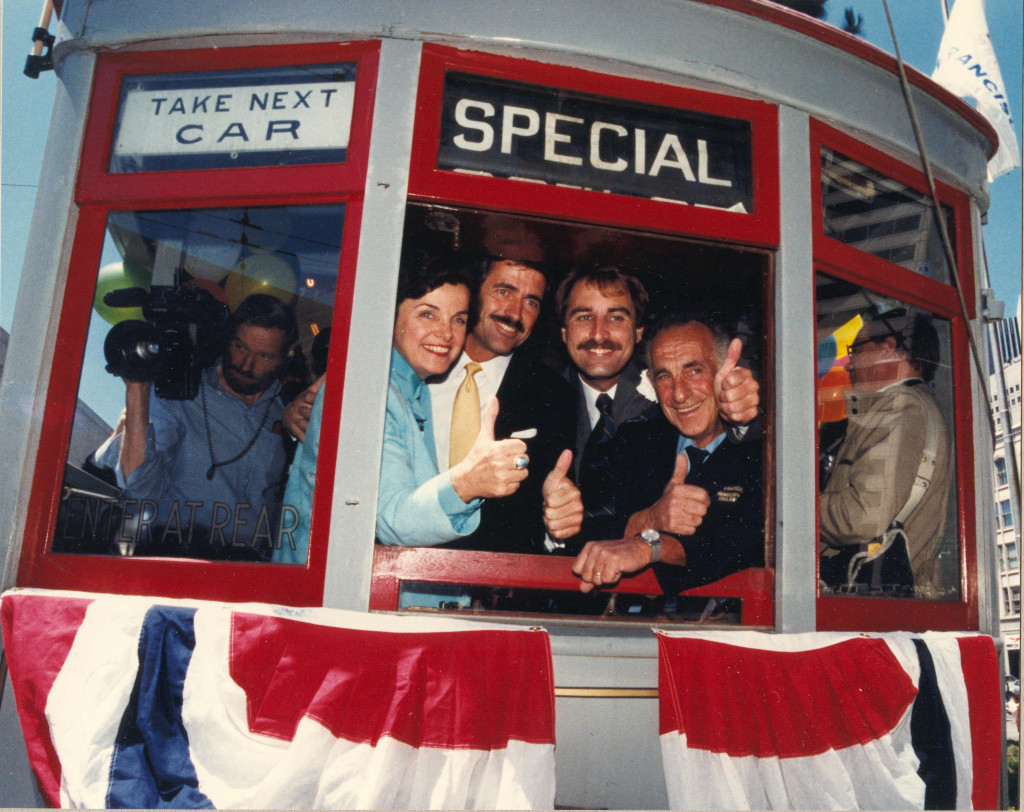
Evolution of the dream
Many people don’t realize that two vintage streetcar operations—the F-line on Market Street, and the E-line on The Embarcadero—were actually proposed before the first Trolley Festival took place. The idea of retaining streetcar service on the surface of Market, using vintage trolleys, was first proposed by the group San Francisco Tomorrow in 1970. In 1974, at the request of then-Supervisor Dianne Feinstein, Muni planner Gerry Cauthen drew up a proposal for a waterfront streetcar line from Caltrain to Crissy Field, using replica vintage streetcars and the existing State Belt and Army freight tracks. By 1980, conceptual proposals for both an E-line (from the Caltrain Depot to Fort Mason) and an F-line (the length of Market Street) had been included in Muni planning documents.
In the fall of 1982, Muni was preparing to retire the last of its streamlined PCC streetcars that had served Market Street for 35 years, and in their place begin full-time streetcar service in the Muni Metro subway beneath Market Street, using modern light rail vehicles built by Boeing. To commemorate what most thought would be the end of 122 years of continuous rail service on the surface of Market Street, Muni ran 1912 Car 1 (its oldest streetcar) and 1923 Car 178 (borrowed back from a museum) along the J-line on Market and Church Streets for a few weekends.
Some Muni planners held out hope that this two-car service would spur interest in a permanent F-line, but the service wasn’t frequent enough to catch the attention of many people.
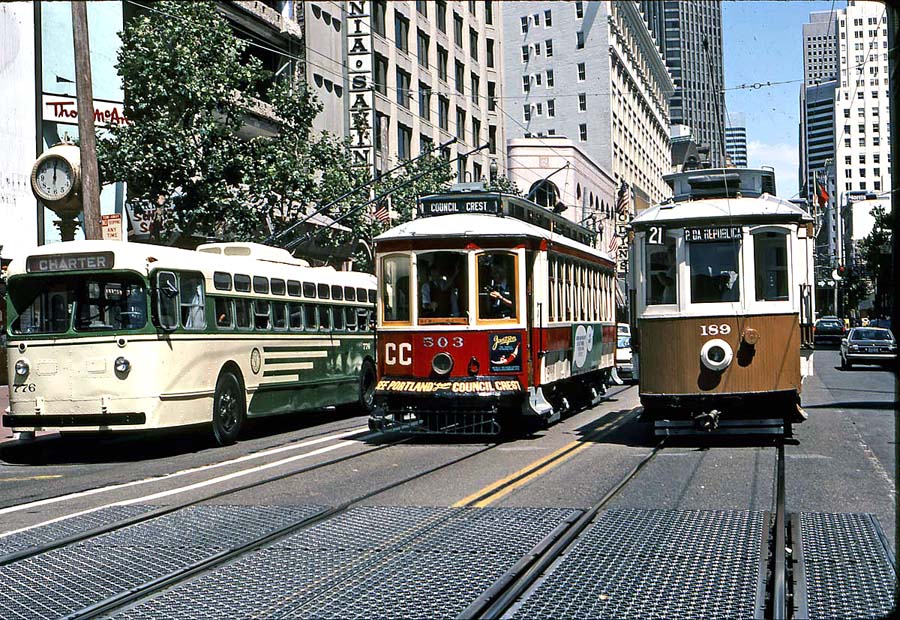
But the special service gave the author, who then served as chair of the Chamber of Commerce Transportation Committee, an idea. The cable cars were about to be shut down for a 20-month rebuilding. Why not expand the two-car weekend service into a summer-long event that could be promoted as an ‘alternative transit attraction’ to the cable cars?
Easier dreamed than done, as it turned out. The author put together a plan to lease several vintage streetcars, and add a couple more of Muni’s own streetcars, and gained critical support from the late John Jacobs, then the Chamber’s president. Together, they went to see Mayor Dianne Feinstein, who heard their pitch and said, memorably, “All right, but I don’t want to see any junk out there.” (Her reference was probably to the dilapidated condition of the just-retired PCC streetcars.)
Enthusiasm and suspicion
As the Chamber began spreading the word about the proposal, the concept was met with both enthusiasm and suspicion. Some in Muni were dubious; a few were downright hostile, but the arrival of uber-railfan Harold Geissenheimer as general manager drove that hostility underground (so to speak). Work began on a ‘temporary’ service pit and storage area at Market & Duboce, where the N-Judah surface tracks in the shadow of the US Mint were no longer needed. Shop forces went to work on preparing historic streetcars as they arrived, and began converting an old work car back to its original configuration as passenger streetcar 130.
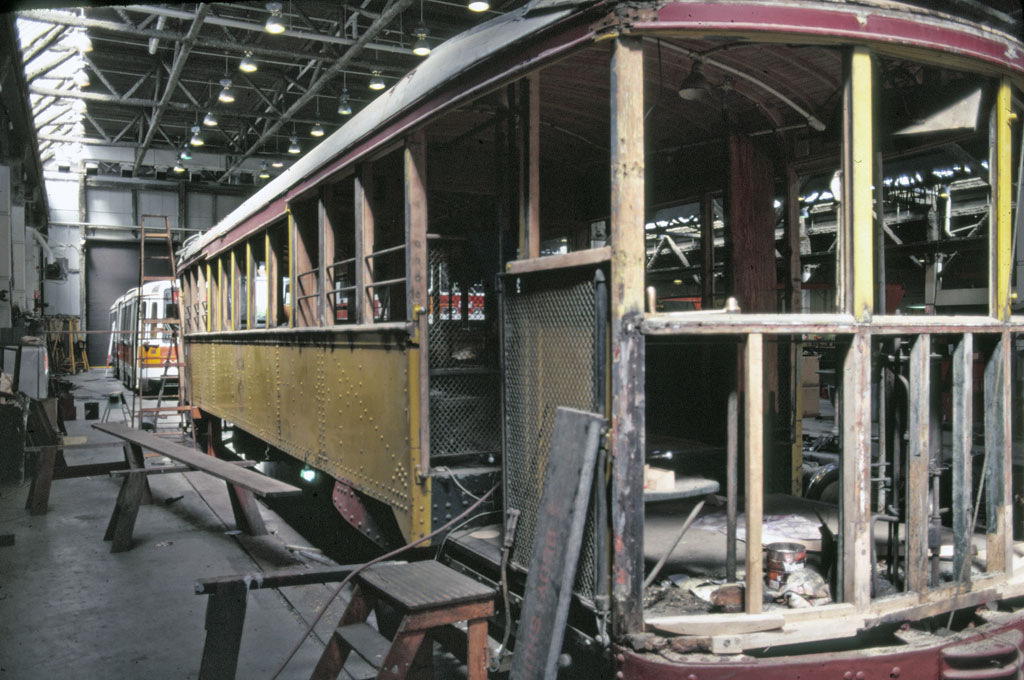
Meantime, some residents of the Castro neighborhood expressed skepticism over the proposal because it came from the Chamber, which was in those days largely identified with large downtown employers. The author met with concerned community members and neighborhood businesses to be sure they were fully involved in planning
and were positioned to benefit from the ridership of the line.
Neighborhood residents were awarded commissions for official Trolley Festival merchandise, including t-shirts and posters, and created their own neighborhood poster as well. Alan Lubliner of the Mayor’s office and the late Lee Knight of the Chamber were very helpful with both neighborhood relations and a wide range of other important activities that made the first festival a reality.
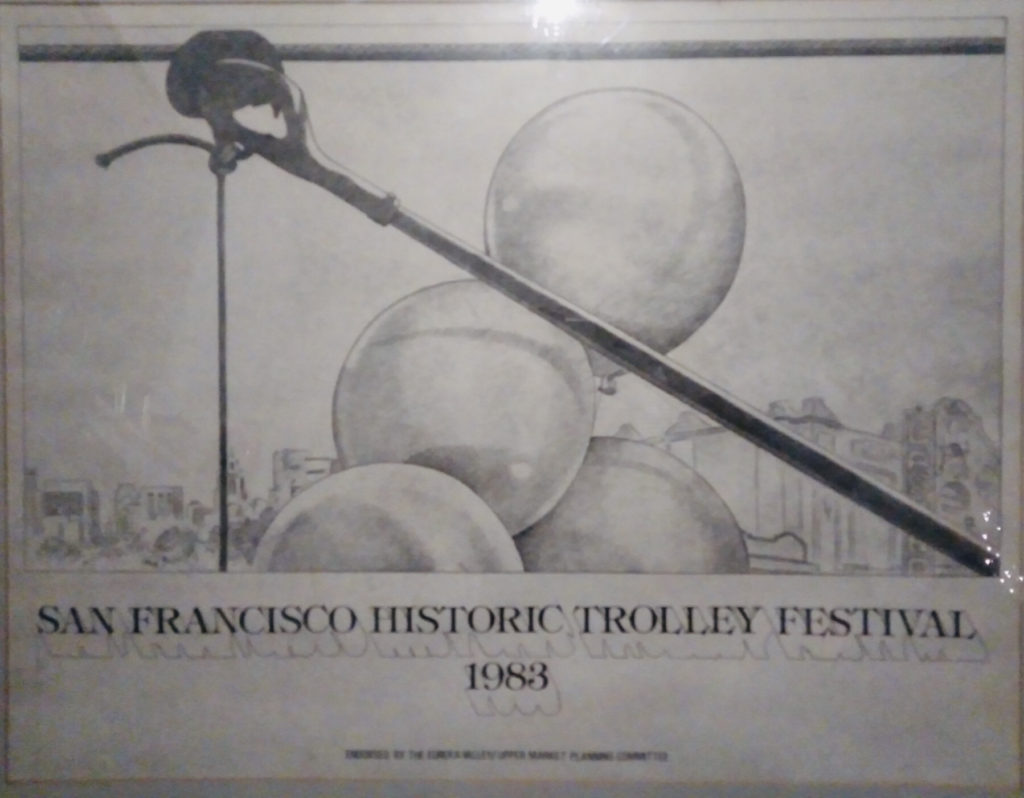
All the while, the author was beating the bushes for vintage streetcars. A trip to New
Orleans yielded hope of borrowing a famed St. Charles Avenue ‘Perley Thomas’ streetcar, but the City Council wouldn’t let one go. (San Francisco finally got one through the efforts of Mayors Willie Brown and Marc Morial fifteen years later.) Visits to eastern museums focused on a New York ‘Third Avenue’ car and a Montreal trolley, but again, agreement could not be reached. But other efforts were successful, including the purchase of a recently retired 1930 W2 class tram from Melbourne, and lease of three cars from an Oregon railfan named Paul Class who was planning for a future vintage line in Portland.
Adventures in transport
Getting the streetcars to San Francisco proved to be an adventure. The author was awakened at 3 a.m. one day by a distraught Paul Class, en route from Oregon. He had almost decapitated Porto, Portugal Car 189 on a Nimitz Freeway overpass. The car wasn’t damaged, but he was shaken and wanted help to get the car safely across the Bay Bridge. Another streetcar, Milwaukee No. 978, leased from the East Troy museum in Wisconsin, began sagging badly near St. Louis on the back of the tractor-trailer hauling it. Turned out to be badly corroded underneath (a common problem with historic streetcars from snowy areas, we learned—the hard way). It finally got here, but wasn’t street-worthy and had to be returned. Thankfully, the Chamber had insured it.
Then there was the seemingly simple task of getting the vintage streetcars from Geneva Division (now Cameron Beach Yard), Muni’s only streetcar storage and maintenance facility at the time, to the F-line itself. In those days, the J-line ended at 30th & Church and didn’t continue to Geneva Division.
All streetcars had to get back to the carbarn through the Twin Peaks Tunnel, opened in 1918, but in 1983 newly connected to the new Muni Metro subway. There were (and still are) exit tracks that come up to the surface near Castro and Market, but there was still work going on at Forest Hill Station, restricting vertical clearance. Not a problem for the new light rail vehicles, but how about the old streetcars? One night we all found out! Everything that could be removed from the roofs of the taller cars was, and they slipped through one by one, with just a couple of inches to spare sometimes. The tower in the center open ‘Boat Tram’ from Blackpool, England, cut it so close that part of its trolley pole actually bowed above the trolley wire. But everything made it.
A great team
The last ingredient for success was the operating and maintenance team. Some in Muni believed the historic cars shouldn’t be mixed in traffic with the then-new Boeing light rail vehicles, so they opposed running single-end cars either out the J-line to 30th Street or the N-line to 30th Avenue. There was only a temporary crossover on 17th Street near Castro the first year, so only double-end cars could terminate there.
Others just plain thought the whole Festival idea was stupid.
Fortunately, there were plenty of ‘can do’ people at Muni too, including veterans of
the old ‘Iron Monsters’ (Muni’s first streetcar fleet, parts of which ran in service until 1958), as well as younger employees excited by the prospect of working on these antiques.
Two Muni veterans ran the daily operations: Carl Barton as overall manager and Rino Bini as front-line inspector. Many veteran operators gave up higher-paying runs in the Metro subway in favor of the Trolley Festival cars, including Jack Smith, Chip Palmer, Tom Biaggi, Walt Thomsen, David Strassman, Lee Butler, Ray Fontaine, Jim Fine, Ray Walker, and Joe Batiste. Warren DeMerritt oversaw maintenance, with Karl Johnson applying his deep knowledge of historic streetcars to day-to-day maintenance, joined by Don Troya, Larry Fried, Ben Lam, and Wally Linn. Art Michel, later president of Market Street Railway, our nonprofit, joined the Festival maintenance team later in the 1980s.
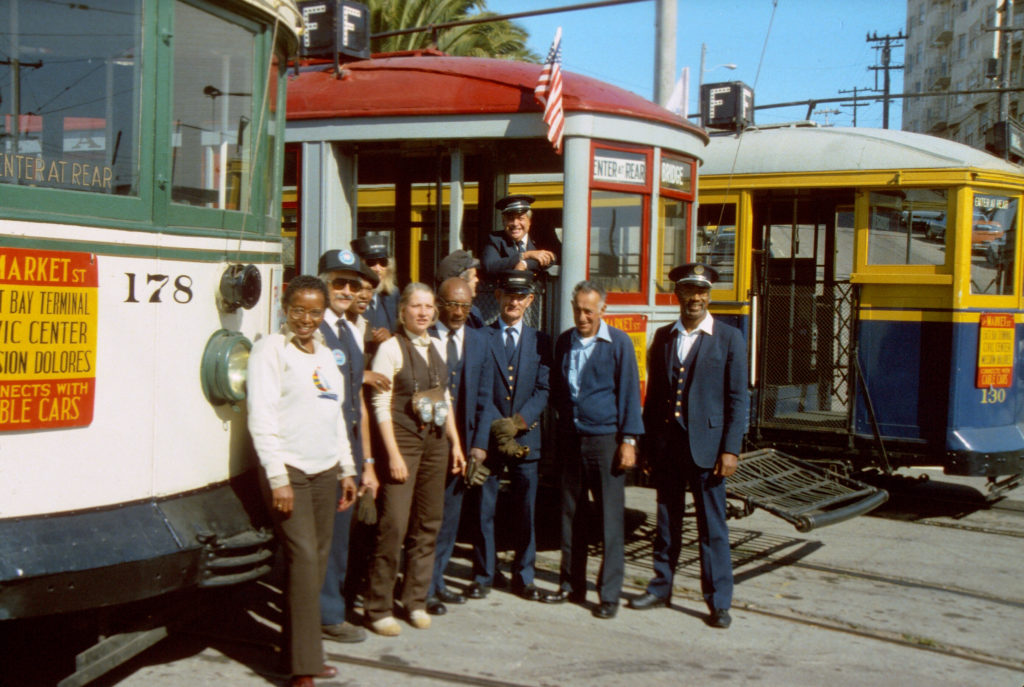
Trolley Festival crews with three original Muni streetcars at Duboce Yard during the first Trolley Festival, 1983. Maurice Klebolt smiles from the platform of Car 1, center. Rick Laubscher photo, MSR Archive
And operating (figuratively) in his own inimitable manner here there and everywhere, was the eminence grise of the Trolley Festival, Maurice Klebolt, lifelong railfan, travel agency owner, regular campaign contributor to the city’s politicians, and part-time Muni operator. Klebolt’s name was given to the author very early in the festival planning process as someone both knowledgeable and powerful, someone who must be on the team.
Klebolt proved invaluable in solving any number of problems, moving matters forward by blustering, cajoling, wheedling, whatever it took. He even had his own streetcar, a 1954 Hamburg tram he had imported without Muni authorization in 1979 and ‘presented’ to Mayor Feinstein, in an attempt to jump-start the E-line concept.
Successful launch
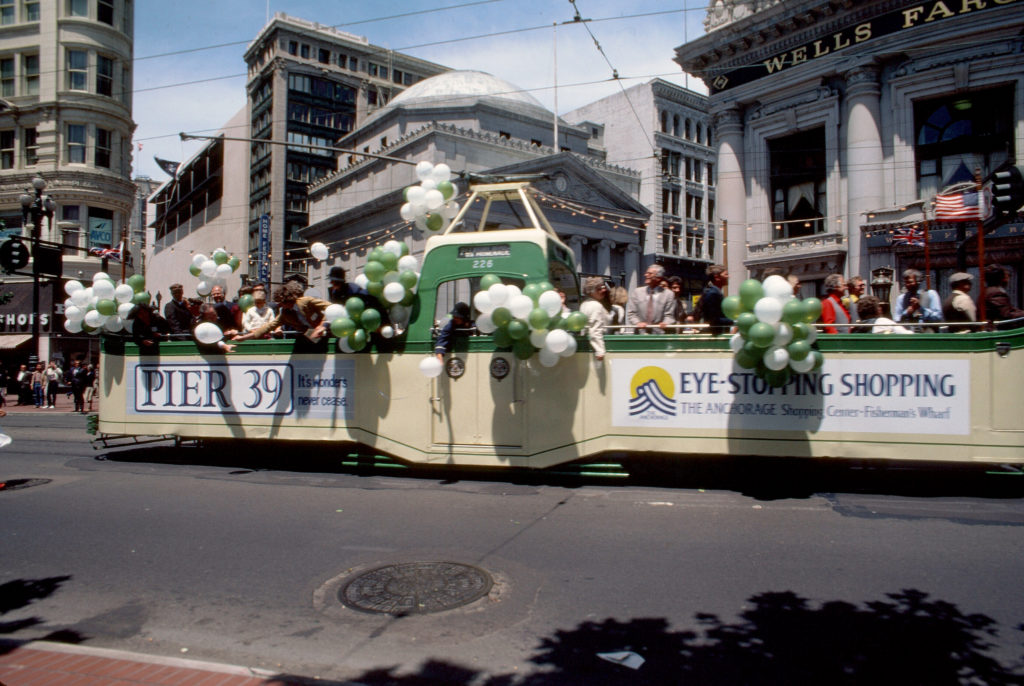
Following much frantic last minute activity by both Muni and its Chamber of Commerce partner (whom the author served as project manager), it all came together on June 23, 1983, when Mayor Feinstein gave a brief speech at 17th & Castro Streets, then wound up the controller of car No. 1 and led a parade of vintage streetcars, buses, and other vehicles down Market Street to Transbay Terminal, officially opening the first San Francisco Historic Trolley Festival.
Many of us also expected it to be the last—a one-year demonstration project to show that vintage transit vehicles could meet today’s everyday transit needs. To keep costs down, it was a one-shift service: eight hours per day, five days per week: Wednesday through Sunday from about 10:30 am to 6:30 pm. It ran through late September and ended with what some considered a farewell parade.
But the Festival proved so popular with locals and visitors alike, Mayor Feinstein asked that it be repeated again, on a longer schedule. Additional cars were found to replace the ones that had only been leased for one year, while other cars on hand—including Klebolt’s Hamburg tram—were restored to operating condition. Again in 1984,
success…so much so that the Festivals continued every summer through 1987, with steadily expanding hours of operation.
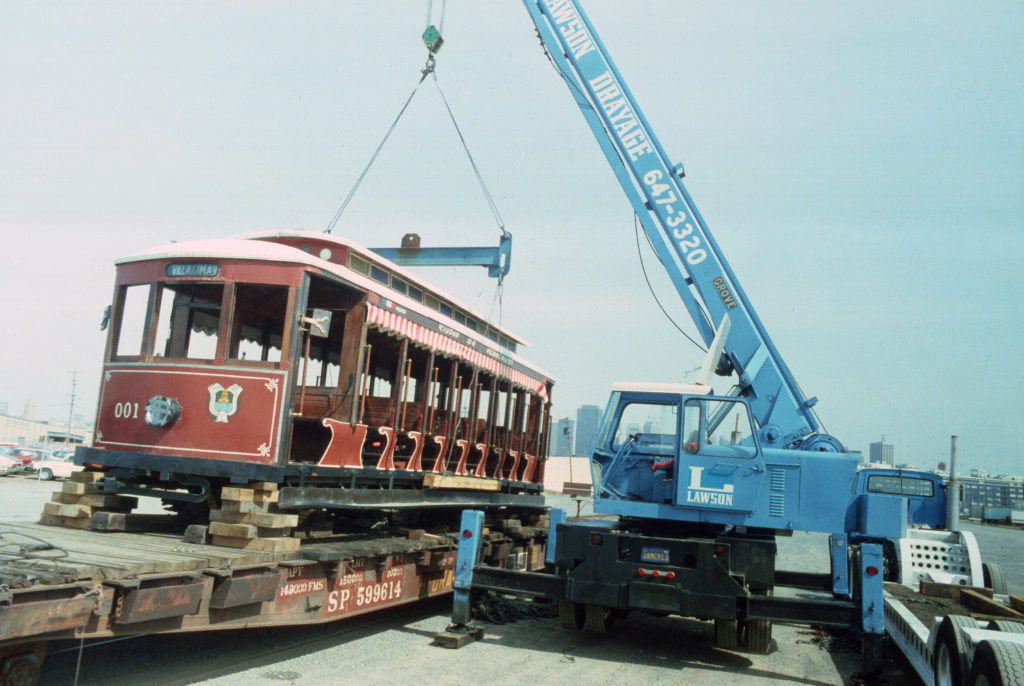
Point proved
By that time, the value of historic transit on San Francisco’s main street had been indisputably established, and plans and funding were in place to begin construction of the permanent F-line.
Advocating and staging the Trolley Festivals carried an element of risk. Had ridership been poor, or had Castro residents not embraced the service as warmly as they did, it could have doomed a permanent F-line. There was, after all, a significant element inside Muni at the time who wrote the F-line idea off as a ‘toy train’. Even after Market Street construction was nearing completion in 1995, a senior Muni official (who has since left the organization) openly bragged that he was going to ‘kill’ the Embarcadero section, despite repeated votes by Muni’s governing body and the Board of Supervisors to build it. But in the end, it moved forward.
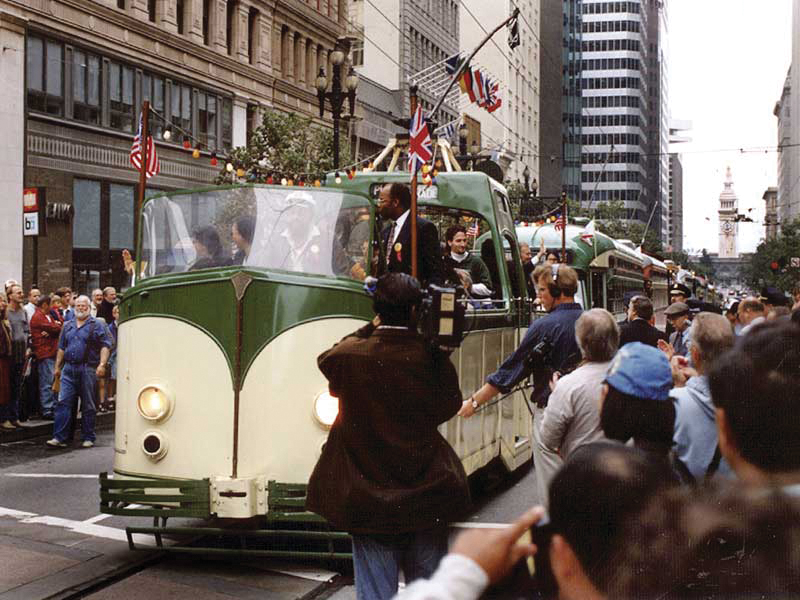
The Market Street segment of the F-line opened in September 1995 and immediately shot way beyond ridership expectations. When the Embarcadero extension opened in 2000, the same thing happened. The original order of seventeen restored PCCs, which some planners thought would be plenty for the extended line, turned out to be not half enough. A group of ten vintage 1928 ‘Peter Witt’ type trams from Milan, Italy, was hurriedly acquired, but demand kept growing. Ever since, our nonprofit, Market Street Railway, has served as Muni’s preservation partner. Since we first became involved during the Trolley Festivals, we have helped Muni acquire more than two dozen streetcars, including: both Blackpool boat trams now in the fleet; two Melbourne trams; one of Muni’s original streetcars, 162, built in 1914; the last surviving full-sized Market Street Railway streetcar, 798; a New Orleans “Streetcar Named Desire”; and many others.
Market Street Railway doesn’t take the success of vintage streetcars in San Francisco for granted. Our board of directors recognizes that it comes as the result of constantly striving to demonstrate the value of historic transit in daily operation, along with constantly monitoring the planning, political, and financial processes of city government to identify bottlenecks and help keep improvements to the city’s historic streetcar service on track.
Quite a show
The author has often been asked: If he knew before starting on the Trolley Festival how much work would be involved, would he have still done it? The short answer is, You bet!
It was a lot more work than anticipated, but it was a great learning experience, and it clearly paved the way for the hugely successful operation of historic streetcars on Market Street and The Embarcadero we all enjoy today. Whether you’re from the Mickey Rooney-Judy Garland generation or the High School Musical generation, it’s something to celebrate.
To see all of those neat historic cars plodding the streets of San Fransisco is a dream come true. But then, to see a number of ex-Philadelphia PCCs from my childhood is extraordinary. I thank the forward-thinking people who brought this project to fruition with their never-ending hard work.
I hope you’re ernjoying PHILADELPHIA,PA. contribution of PCCs
in San Francisco…They were good cars when they ran here…
Unfortunately SEPTA management didn’t want them..that’s why
you got them…They were CLASSIC everyday cars here…
I started loving PCC’s in 1944 as a very young boy. I loved the sound they made when they crossed other tracks..and ended up riding almost every PCC in the PTC (later SEPTA) collection..even driving a few here and there. I new how to drive the hand-controlled SER cars as well..Got the chance to ride a few in SF…not sure that I like the new motor noise..the old was quieter on our 2700 cars…and the way they made the new PCC-II cars look is awful as far as I’m concerened. It looks like a top-heavy rocket-ship, and the wheels do NOT seem to have the rubber-inserts the 2100 and 2700 all-electric cars in Philly did. Hope to get back and ride more soon.
I’m a native. Although I was born in ’42; growing up I remember
during the ’50’s some street rails that still existed but in some cases; no longer used. Other rail-lines were used but then discontinued by the beginning of the ’60’s. Many of the Streets of today – such as Geary Street (or Geary Boulevard) were made to be wide enough to accommodate surface rails. On Geary Street, the areas used for rails are now nothing more than concrete islands blended with both wind-blown garbage, Ivy as well as sickly looking bushes. The fact is; these street islands are presently nothing more than wasted as well as lost space. It was a mistake to have removed the rail systems from Streets like Geary Blvd. and California Street to begin with. Perhaps in time, the rail system here can be returned.
In 1971, I rode a charter car on what was to be the last
streetcar on Upper Market, following the last scheduled car. The Market Street rails were then ripped up, so that
the cars could make the Market-Duboce-Church-17th-
Twin Peaks Tunnel diversion.
Who’d have thought that Market Street is back and flourishing? Until my visit this past February, it
had been a decade since my last time in San Francisco.
The F Line is wonderful!
The F-Line is superb. I came every year to San Francisco and obviousky for me from Milan is wonderful to see our Peter Witt running far from home.
Rode the rte.47 everyday to C.D.high school ! Also rode the rte.50 quite a bit. Have recently visited philadelphia and got sick to see the decay of the trolley system ! Septa is nothing more thana bus co. The trolley barn at 10th& Luzurne is a cardboard factory !